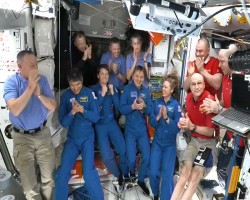UPSC Current Affairs
TABLE OF CONTENTS |
| Science and Technology |
|---|
|
|
|
Why in News?
A SpaceX Crew Dragon mission successfully docked with the International Space Station (ISS) on March 17, 2025, bringing relief to two astronauts who had been stranded in space for over nine months due to a failed return mission. What Happened? NASA astronauts Butch Wilmore and Sunita Williams have been stuck aboard the ISS since June 2024 due to propulsion issues in the Boeing Starliner spacecraft, which was originally meant to bring them back to Earth. Their mission, intended to last only a few days, extended into nine months, significantly longer than the standard ISS crew rotation of six months. The Starliner was deemed unfit for return travel, forcing the astronauts to remain on the ISS until a replacement crew could be sent. Background: Boeing Starliner’s Maiden Crewed Mission Mission Overview: The Boeing Starliner spacecraft was launched on its first crewed mission in June 2023, carrying Wilmore and Williams to the ISS. The mission aimed to test the spacecraft’s capabilities for future crewed flights. Technical Issues: During the mission, the Starliner experienced propulsion system malfunctions, making it unsafe for the astronauts to return. The spacecraft was eventually sent back to Earth empty, leaving the astronauts stranded. Extended Stay: The standard ISS rotation for astronauts is approximately six months. Wilmore and Williams’ nine-month stay is one of the longest in recent history, highlighting the challenges of space travel and spacecraft reliability. SpaceX Crew-10 Mission Details Launched from Kennedy Space Center, Florida on March 15, 2025. The Crew-10 team successfully docked with the ISS at 0545 GMT (1115 IST) on March 17, 2025. The new crew was welcomed with hugs and cheers by Wilmore and Williams, who expressed relief and joy upon seeing their colleagues. Next Steps for the Stranded Astronauts Butch Wilmore and Sunita Williams will begin preparations for their return to Earth. Their splashdown in the ocean off the Florida coast is scheduled for no earlier than March 19, 2025. NASA officials will closely monitor the return mission to ensure their safety. Key Facts About the ISS and Space Missions International Space Station (ISS): The ISS is a collaborative project involving NASA, Roscosmos (Russia), ESA (Europe), JAXA (Japan), and CSA (Canada). It serves as a microgravity and space environment research laboratory. SpaceX Crew Dragon: The Crew Dragon spacecraft, developed by SpaceX, has become a cornerstone of NASA’s Commercial Crew Program, providing a reliable means of transporting astronauts to and from the ISS. Boeing Starliner: The Starliner is Boeing’s contribution to NASA’s Commercial Crew Program. Despite its recent setbacks, it is expected to play a key role in future crewed missions once its technical issues are resolved. Challenges Faced Technical Failures: The Boeing Starliner suffered propulsion issues, making it incapable of a safe return. Extended Stay in Space: The astronauts had to adjust to prolonged microgravity conditions, which can affect muscle mass and bone density. Mission Delays: NASA had to reschedule multiple return missions before confirming the Crew-10 replacement. Significance of This Mission Strengthens SpaceX’s Role: SpaceX's Crew Dragon program continues to be a reliable alternative for space missions, particularly after issues with Boeing’s Starliner. Safety & Redundancy: Highlights the need for multiple return vehicle options in case of future emergencies. Human Endurance in Space: Provides valuable insights into long-duration space missions and astronaut adaptation. Conclusion The successful docking of SpaceX Crew-10 marks a critical milestone in ensuring astronaut safety and space mission reliability. As Wilmore and Williams prepare for their return, the mission underscores the importance of redundancy and reliability in space exploration. |
|
<< 15-Mar-25
|
|
|
